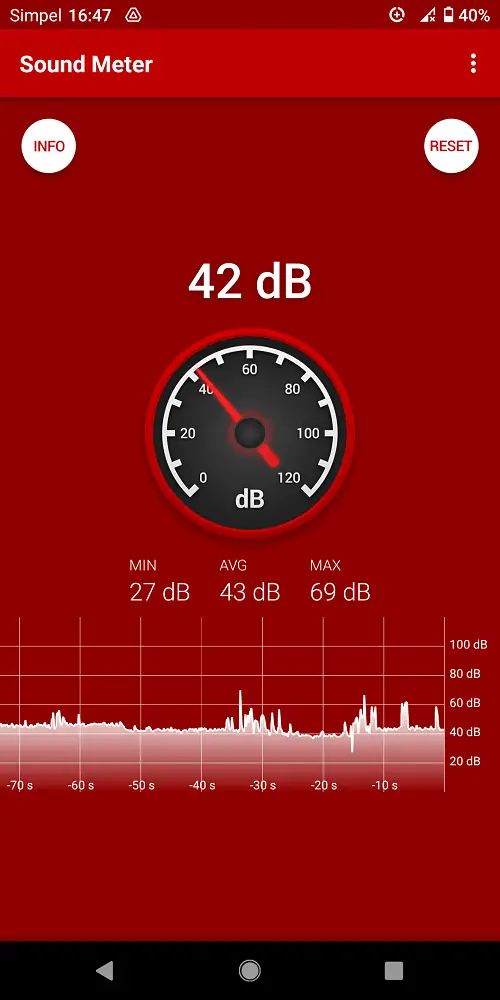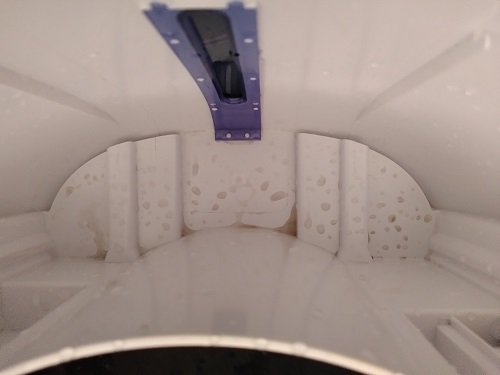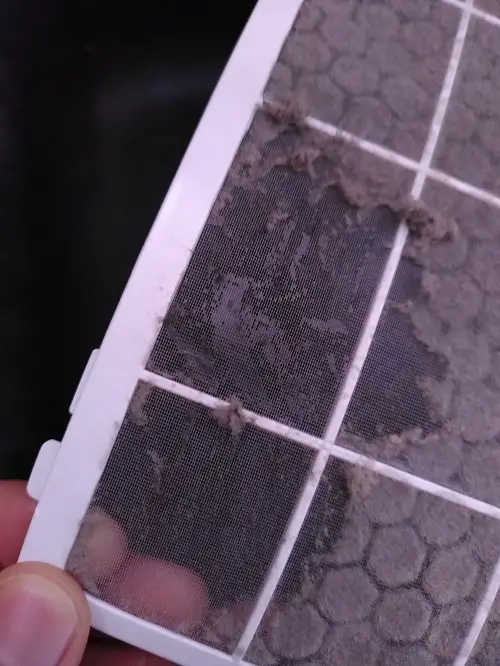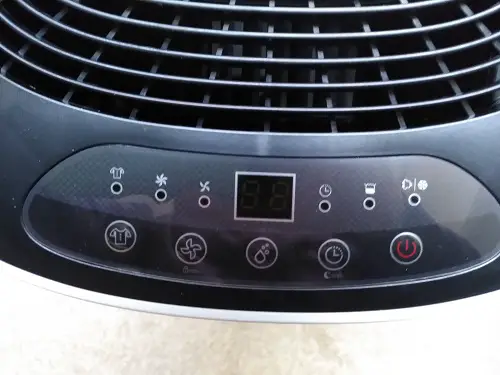There are a few disadvantages to using a dehumidifier. This article goes into depth about common issues and the ones I encounter with my own dehumidifier.

The disadvantages of running a dehumidifier are:
- Noise: although relatively low (38- 65 dB), it can be distracting
- Electricity use: although relatively low (200 to 500 Watt), it has to run for many hours
- Purchase cost: you should expect to pay between $100 and $250
- Increase of air movement: this worsens air quality by making settled-down dust airborne again
- Requires regular maintenance: emptying the water tank, cleaning the filter
- It requires closed windows and doors: ventilation should be minimized for optimal dehumidification
Dehumidifiers can be loud
Dehumidifiers can make quite some noise. Up to 65 decibels. That is similar to a conversation, but below TV volume. Because of this, running a dehumidifier in an otherwise quiet room or office space can be distracting.
However, the amount of noise a dehumidifier makes is dependent on the one you are using. Some models are much quieter than others. Desiccant dehumidifiers tend to be relatively quiet at around 40 dB. Compressor dehumidifiers often produce around 50 dB.
Unfortunately, compressor is the most suitable and therefore most common household dehumidifier type.
Dehumidifier noise: personal experience
I bought the quietest (compressor) dehumidifier that still fits my needs and budget. However, it still is quite loud when running at maximum fan speed. ‘Luckily’ I live in a busy city center where there are many noises all around. Therefore, the dehumidifier doesn’t bother me too much.
The difference between busy city center noises and the sound of the dehumidifier is quite large. Not necessarily in decibels, but the dehumidifier hums continuously, which is not too bothersome. Loud noises from the city are much more infrequent, and therefore more distracting.
I downloaded an app called Sound Meter to measure the decibels in my living room. They are around 38 when I’m 6 meters from the dehumidifier. Right next to the dehumidifier, the decibels are up to about 42. Not that bad actually.
Here’s a screenshot of my measurement:

A dehumidifier constantly uses electricity
A dehumidifier needs to run all day to do its job optimally. If not, because of ventilation, incoming fresh humid air will undo much of the work.
Therefore, it will need to run for many hours, and consume electricity constantly. Dehumidifiers do not use all that much wattage. Its energy use greatly depends on the device’s capacity. A dehumidifier designed to quickly dehumidify a large living room might use 700 watts. A small dehumidifier could use only 50 watts. My own dehumidifier, which can remove between 5 and 10 liters of water per day, uses about 143 watts.
However, by running constantly, they will noticeably add to your energy bill at the end of the month.
The expected costs of running a dehumidifier 24/7 will be something like the following:
- runs 24/7
- runs 30 days per month
- uses 300 watts per hour (0.2 kWh)
- electricity price of 14.2 cents per kWh (source: US Energy Information Administration)
This makes for a total of 216 kWh per month (0.3 kW x 24 hours x 30 days = 216 kWh per 30 days).
With a price of 14.2 cents/kWh, this leads to a monthly cost of approximately $30.
Dehumidifier energy use: my experience
My own dehumidifier actually seems to use a little less energy than advertised. According to the data gathered by a smart socket shown on the smart life app, it is using around 143 Watts. However, the manual of the device says to use about 165 W. Perfect!
Still, I run the device about 5 hours a day (before and after work). Therefore, my energy use increased by 143 x 5 = 715 kWh. This means that my energy bill increased by about $ 0,10 per day.

Dehumidifiers can be expensive
Naturally, a better and larger dehumidifier will cost more. The following table shows the price of several high-rated dehumidifiers.Dehumidifier Price Area coverage
Water removal/dayREEMKIZZ 2300 $35 218 sq. ft. 16 oz (0.5 liters) AIRPLUS 30 $145 1500 sq. ft. 30 pints (14 liters) MeacoDry ABC 12L $170 1250 sq. ft. 25 pints (12 liters) Danby 40 $250 3000 sq. ft. 40 pints (20 liters)
I recommend not simply purchasing the cheapest model. Make sure to find one that suits your specific needs such as area coverage and water removal speed. I wrote an article to help you find the best dehumidifier for your needs. You can find it here:
Air circulation can worsen air quality
Dehumidifiers increase air circulation by running a fan. They suck in air to be able to remove the moisture and let out the dry air again. This can be an air quality problem because air circulation causes settled-down dust particles to become airborne again. When these dust particles become airborne, they can easily be breathed in, which can be harmful to our lungs.
Luckily, most dehumidifiers come with a good air filter. This means that some of the airborne dust particles are being filtered by the device. However, I recommend making sure the room is cleaned of dust. Additionally, make sure to clean the filter often.
If you would like to read more about the impact of dehumidifiers on air quality, I recommend reading my article. It discusses the positive and negative impact a dehumidifier has on the healthiness of your air.
Dehumidifiers require regular maintenance
Dehumidifiers can be quite some work. Their container not only needs to be emptied once or twice a day, but its dust filter also needs to be cleaned or replaced every couple of months.
The container needs to be emptied frequently
The dehumidifier I am personally using (MeacoDry 12L) has a container of 2.6 liters (5.5 pints). Since the device can remove about 12 liters per day in optimal conditions, I will need to empty the container about 4.5 times per day. This means I need to empty the machine once every 5 hours.
However, this moisture removal speed is based on optimal conditions of 30 °C (86°F) and 80% relative humidity (RH). At suboptimal conditions 0f 27°C (80°F) and 60% RH, its moisture removal speed is down to only 7.5 liters per 24 hours (16 pints). Which is still very unrealistic in a regular living space.
Therefore, the expected moisture removal is even lower than that, and then you will likely only have to empty the container about once or twice a day. Or once every 10 hours.
Make sure to always empty the container when you shut down the device. Otherwise, the water inside the container has the chance of evaporating again.
You can expect to have to empty the container once or twice a day

The add-on drainage hose doesn’t work
Without purchasing a pump to get the water from the container through the hose, it simply doesn’t work as intended. The drainage hose you can purchase as an add-on to the dehumidifier is simply a regular hose. One end goes into the container of the dehumidifier while the other goes into the sink. The continuous emptying entirely works based on gravity. Therefore, the dehumidifier needs to be placed higher than the sink. This is almost never the case since the device is designed to be placed on the floor.
To achieve automatic drainage, you will either need to place the dehumidifier higher than the sink or purchase a separate pump.
A large container is difficult to handle
Another option is to purchase a dehumidifier with a larger container. A large container takes longer to fill, so you will need to empty it less often. However, I recommend going with a container no larger than 3 liters (6 pints). When the container is too big, it won’t be very easy to lift, move, or empty. A large container full of water will easily spill when you carry it to the sink. Also, it is likely to make a mess when you’re trying to empty it.
Dust filters need to be cleaned and replaced
As I mentioned, dehumidifiers have a simple dust filter that will accumulate dust over time. Dust build-up means that the incoming air is being blocked. Therefore, it needs to be cleaned regularly. The recommended frequency of cleaning is about once every two months. If your room is especially dusty, check the filter more regularly and see if it needs to be cleaned more often.
Although these filters are easily washable, they sometimes need to be replaced. Replace your dehumidifier filter whenever you see holes or tears. These damages to the filter mean that dust can flow through and enter the device. This might reduce the effectiveness or harm your dehumidifier. Replacing a dust filter will cost somewhere around $20 to $40.
Some dehumidifiers include an alarm that goes off when the filter needs to be cleaned. For more information, visit amazon.com.

A dehumidifier requires closed windows and doors
For a dehumidifier to function optimally, doors and windows need to be closed and ventilation should be minimized. Any type of ventilation introduces fresh air, which also introduces water vapor. The fresh air will mix with the relatively dry air in your room, increasing the humidity and undoing the work of your dehumidifier.

Ventilating and running a dehumidifier: my experience
My home has a lot of natural ventilation, meaning there are many ways for fresh air to come in even when doors and windows are closed. Therefore, unsurprisingly, my dehumidifier has a lot of trouble reducing the humidity. On bad days with a lot of humidity, the humidity levels can be around 80% when I turn on the device in the morning. During the day, the humidity drops very slowly even though the device is well suited for the size of the room. After many hours, the relative humidity is usually still around 65%.
This already makes a huge difference in comfort. However, instead of purchasing a better dehumidifier, I am planning to work on reducing natural ventilation. I expect to make the dehumidifiers’ life much easier when natural ventilation has been reduced.
Sometimes you should consider not running your dehumidifier. For example, when the temperature is so low that you are risking freezing damage (which already happens below 60 °F (15 °C)). You can find more information in my article:

